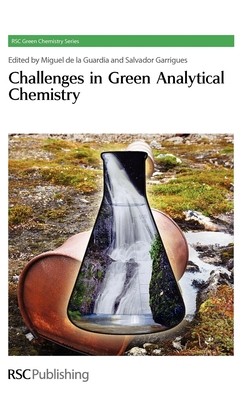
- We will send in 10–14 business days.
- Publisher: Royal Society of Chemistry
- Year: 2011
- Pages: 235
- ISBN-10: 1849731322
- ISBN-13: 9781849731324
- Format: 16.2 x 24.2 x 2.8 cm, hardcover
- Language: English
- SAVE -10% with code: EXTRA
Challenges in Green Analytical Chemistry (e-book) (used book) | bookbook.eu
Reviews
Description
Concerns about environmental pollution, global climate change and hazards to human health have increased dramatically. This has led to a call for change in chemical processes including those that are part of chemical analysis. The development of analytical chemistry continues and every new discovery in chemistry, physics, molecular biology, and materials science brings new opportunities and challenges. Yet, contemporary analytical chemistry does not consume resources optimally. Indeed, the usage of toxic chemical compounds is at the highest rate ever. All this makes the emerging field of green chemistry a "hot topic" in industrial, governmental laboratories as well as in academia. This book starts by introducing the twelve principles of green chemistry. It then goes on to discuss how the principles of green chemistry can be used to assess the 'greenness' of analytical methodologies. The 'green profile' proposed by the ACS Green Chemistry Institute is also presented. A chapter on "Greening" sample preparation describes approaches to minimizing toxic solvent use, using non-toxic alternatives, and saving energy. The chapter on instrumental methods describes existing analytical approaches that are inherently green and making non-green methods greener. The final chapter on signal acquisition describes how quantitative structure-property relationship (QSPR) ideas could reduce experimental work thus making analysis greener. The book concludes with a discussion of how green chemistry is both possible and necessary. Green Analytical Chemistry is aimed at managers of analytical laboratories but will also interest teachers of analytical chemistry and green public policy makers.
EXTRA 10 % discount with code: EXTRA
The promotion ends in 19d.06:37:32
The discount code is valid when purchasing from 10 €. Discounts do not stack.
- Publisher: Royal Society of Chemistry
- Year: 2011
- Pages: 235
- ISBN-10: 1849731322
- ISBN-13: 9781849731324
- Format: 16.2 x 24.2 x 2.8 cm, hardcover
- Language: English English
Concerns about environmental pollution, global climate change and hazards to human health have increased dramatically. This has led to a call for change in chemical processes including those that are part of chemical analysis. The development of analytical chemistry continues and every new discovery in chemistry, physics, molecular biology, and materials science brings new opportunities and challenges. Yet, contemporary analytical chemistry does not consume resources optimally. Indeed, the usage of toxic chemical compounds is at the highest rate ever. All this makes the emerging field of green chemistry a "hot topic" in industrial, governmental laboratories as well as in academia. This book starts by introducing the twelve principles of green chemistry. It then goes on to discuss how the principles of green chemistry can be used to assess the 'greenness' of analytical methodologies. The 'green profile' proposed by the ACS Green Chemistry Institute is also presented. A chapter on "Greening" sample preparation describes approaches to minimizing toxic solvent use, using non-toxic alternatives, and saving energy. The chapter on instrumental methods describes existing analytical approaches that are inherently green and making non-green methods greener. The final chapter on signal acquisition describes how quantitative structure-property relationship (QSPR) ideas could reduce experimental work thus making analysis greener. The book concludes with a discussion of how green chemistry is both possible and necessary. Green Analytical Chemistry is aimed at managers of analytical laboratories but will also interest teachers of analytical chemistry and green public policy makers.


Reviews